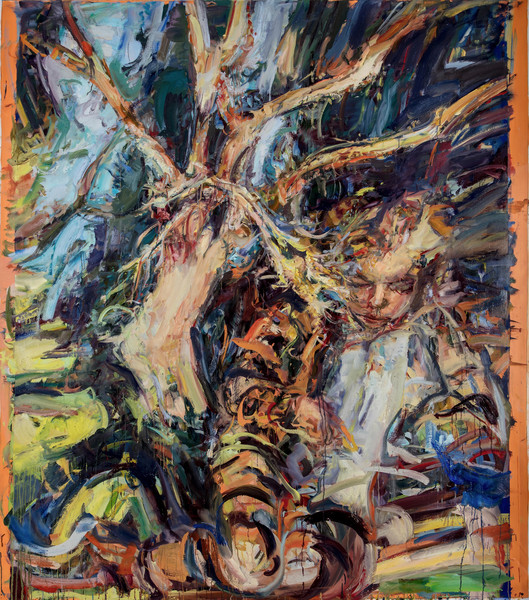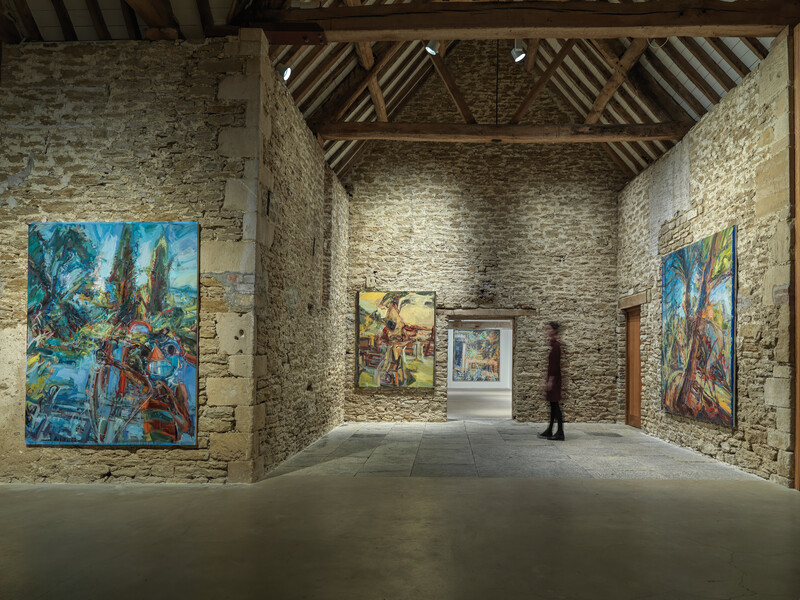
Catherine Goodman
Eve
19 January - 6 May 2019
Somerset
Hauser & Wirth Somerset is pleased to present an exhibition of new paintings by London and Somerset based artist Catherine Goodman. Goodman was artist-in-residence at Hauser & Wirth Somerset from January to May 2018 and many of the works in the exhibition were made during her residency. Her practice includes expressionistic landscapes, vigorous sketches, experimental collages and portraits; central to her process is the act of drawing from observation, whether from life, objects or the great masters and their works. She has travelled extensively, working for many years in India and the Mediterranean landscape.
The exhibition is titled ‘Eve’ and the majority of works are vibrant, colourful, landscape based paintings occupying the Threshing Barn, Workshop and Pigsty galleries. Goodman describes her residency in Somerset as ‘a quiet, contemplative setting where the idea for this garden grew.’ Although not explicitly representing the ‘Garden of Eden’, these energetic paintings incorporate rich, rural habitats, often with female figures or children merging into the landscape. All of the artist’s paintings begin with drawing from life, which is fundamental to her practice. Whilst on the residency in Bruton, Somerset, Goodman set up and took part in regular life drawing sessions. It was from these sessions that the figure of Eve emerged and subsequently features in several of her paintings. In these works, the artist is investigating an arrival of consciousness, referencing the story of Eve in Genesis. She is exploring the point at which we become aware of shame and lose our childhood naivety, just as Eve becomes aware of her own nakedness. These paintings investigate moral and existential questions elicited by the shaming and blaming of Eve, and the relevance of these ancient archetypes in today’s society.
‘Eve’ (2018) depicts the anguished figure of a woman hunched over, her body intersecting and merging with the trees. Goodman is interested in how an intervention in the landscape – in this case the figure – alters our perception of it. In this series she is exploring the poses of these ambiguous figures and their relationship to the natural architecture of the scene. In other paintings the temporary structure of the hammock – a motif the artist has often returned to – is the tool for shifting our impression of the landscape. In ‘Kiss’ (2018) heavy textural paint and expressive brush strokes combine with splashes of virulent red. A shroud-like hammock is slung between two dark foreboding trees, the coiled rope left to hang in a noose, adding to the painting’s sinister quality. In contrast ‘Departed Presence’ (2018) portrays a brightly striped hammock, swinging invitingly between two sunlit trees.
In ‘Tiger Girl’ (2018) an angelic child dressed in a tiger costume sits in the foreground, a look of relaxed concentration on her face. Behind her a tree is illuminated with a flame-like quality that lends an air of mystery to the work. The freedom and energy of the mark making alludes to movement and transformation. Goodman is fascinated by masks and the notion of children dressing up, playing with the image they inhabit. In ‘We Fight for Paradise’ (2018) the viewer is confronted with a child wearing a grinning blue mask, bearing a bow and arrow against a luscious Mediterranean backdrop. The verdant landscape mirrors the fertile imagination of the child, as yet unsullied by worldly concerns.
The children in the paintings are Goodman’s nieces, with whom she is very close, drawing them regularly. Of her nieces she comments: ‘They are at that stage where they are completely free, but I question what will happen when they come into this world full of social and political challenges?’ Goodman sees her artistic practice as a conduit for understanding where she stands on a subject. She quotes E.M. Forster: ‘How do I know what I think until I see what I say’ and likens this to her own experience that ‘You can have a position and a stance intellectually, but it’s when you’re making images that you actually know what you think about something.’
Goodman’s expressionistic landscapes are predominantly from drawings made in India or Italy – both places the artist has revisited time and again throughout her career. She tends to return to settings that are well known to her, she likens these vistas to homes, saying ‘they have a huge bank and resonance of memory’. Nevertheless these works are not intended to be descriptive paintings about particular places; rather they represent a garden in the artist’s imaginative life.
Watching and drawing from film is another ongoing part of Goodman’s practice, which she describes as ‘feeding off another’s eye’. ‘Beekeeper’ (2018) depicts a scene from the 1973 film ‘The Spirit of the Beehive’ directed by Víctor Erice. The painting, in which a central figure tends a beehive, has a compelling, haunting quality with the face of the figure concealed behind a hood-like mask, eerily reminiscent of a klansman. Goodman describes her drawings from film as ‘quotations’. A series of flags hanging outside the gallery and visible through the windows of the Threshing Barn depict further ‘quotations’ from film. The flags, although much larger in scale, conjure images of the Buddhist prayer flags that the artist has encountered many times on her travels. Goodman acknowledges a certain poetry in the notion of her works beginning as drawings in the landscape, diverging into paintings, and then returning into the landscape as flags.
Selected images

Tiger Girl
2018
Installation views


Related Content
About the Artist

Catherine Goodman
For more than four decades, Catherine Goodman CBE has developed a unique visual language that communicates a powerful visionary response to her lived experience and memory. Goodman’s intensely expressive painting process uses strongly pigmented oil paint, brushwork, oil sticks, drips and washes to create atmospheric and immersive paintings which explore both figuration and abstraction.
Central to Goodman’s artistic process is the act of drawing directly from life, her intimate knowledge of the old master painters and drawing from film, where she immerses in the legends of the modern cinema age. In Goodman’s words, “drawing can bring about a sense of unity and create a portal into other realms of consciousness”. This daily practice roots her mark-making in observation and informs and enriches her paintings.
Catherine Goodman’s role as an educator is integral to her artistic identity. Since graduating from art school, Goodman has been organising drawing classes for the homeless and other community groups, demonstrating a longstanding commitment to social justice in art education. In 2000, this led her to co-establish the Royal Drawing School with HM King Charles III, to address the increasing absence of drawing in art education and to give wider access to disadvantaged students.
Goodman studied at Camberwell School of Arts & Crafts, London, and the Royal Academy Schools, London, where she won the Royal Academy Gold Medal in 1987. Goodman continues in her role as Founding Artistic Director and Academic Board Member of the Royal Drawing School and in 2014 was awarded Lieutenant of the Royal Victorian Order, for her services to arts education. Since 2019, Goodman has served as the Artist Trustee at The National Gallery, London. In 2024, she was awarded Commander of the Order of the British Empire for her services to art, UK.
Her paintings are held in significant private and public collections including Female Artists of the Mougins Museum, France; The Fitzwilliam Museum, Cambridge, UK; The Green Family Art Foundation, Texas, USA; The National Portrait Gallery, London, UK; The Olivia Foundation, Mexico City, Mexico; The Rothschild Foundation, Waddesdon, UK; The Royal Collection Trust, London, UK.
Current Exhibitions
1 / 12











